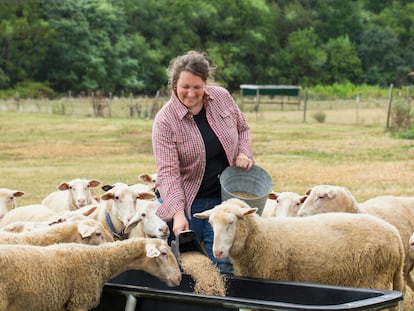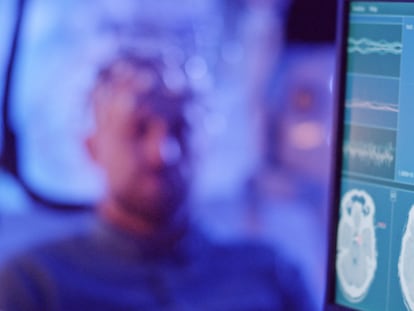Sheena Josselyn, neuroscientist: ‘Eliminating a memory is fairly simple, once you have the right tools’
The researcher in brain mechanisms talks about creating and destroying memories, something she has already managed to do in mice

She thought she wanted to be like the FBI agent played by Jodie Foster in The Silence of the Lambs. Instead, she has spent decades in a laboratory, studying how memories are made. Sheena Josselyn is a researcher at The Hospital for Sick Children, a professor at the University of Toronto and holds a Canada Research Chair in Brain Mechanisms Underlying Memory, among other positions. She was recently in Barcelona, Spain, where she presented the keynote lecture of the European College of Neuropsychopharmacology congress before more than a thousand people. Her talk was titled “Making and breaking memories,” something her research group has managed to do in mice.
We talked with her about memory and memories, how they form and disappear and why we do not remember anything from before we were three years old; about new neurons, experiments that border on science fiction, and whether knowledge actually takes up space.
Question. You were going to study medicine, but in the end you chose psychology. You wanted to work in the clinic, and were even studying sex offenders in prison, but you ended up devoting your time to the molecular study of memory. What happened along the way?
Answer. At the beginning I wanted to go into medicine. I spent a summer working in my family doctor’s office as a receptionist, and I thought my job answering the phone and typing up letters was more exciting [than his]. I was looking for a hard question to try and answer. I studied psychology because it seems like a big question: how does the brain work? What is the mind? What is the brain? I was very much inspired by the movie The Silence of the Lambs and Jodie Foster’s character, who was a match for this sort of evil genius. And I thought that I would be Jodie Foster in real life and be a match for sex offenders. I was very junior on the team, but part of my job was to interview people that were getting ready for parole. But I never found my Anthony Hopkins [laughs]. So I went back to the brain, which has never, never been boring.
Q. And do we know what memory and memories are? Are they just synapses between neurons, electrical impulses?
A. That’s a huge question, what memory is. To be honest, we’re still a little clueless about what’s happening in the brain, and that’s a huge problem for us because there are so many brain problems in which memory can go wrong. There’s something like dementia or Alzheimer’s, but there are also things like depression, where we think that constant rumination of bad memories might be a contributing factor. And there’s much more that we don’t know. You can stimulate neurons that are not connected to each other through synapses and get something that looks like memory retrieval, which is amazing. So synapses are important, but where exactly is the memory held? We don’t know.
Q. The physical form in which memory is stored is called an engram, which is what you mainly study. In your talks you explain that this idea comes from ancient Greece, but it took a lot of effort to prove it, despite the logic that may be behind it. What is an engram?
A. An engram was first defined [in the early 20th century] in a sort of philosophical way, as the lasting trace of an experience in our brain. The definition has sort of undergone a little bit of a change. My definition is: the ensemble or the group of neurons that seem to be important in holding a memory. Some people questioned its existence, but they did not really propose an alternative theory.
Q. Some of those who tried to find it, such as psychologist Karl Lashley, came to the conclusion that memory was in all places in the brain and in no specific place at the same time. But now we know that there are different types of memory; that the same thing will not happen in my brain when I try to remember this room as in that of the person who wants to remember what they read in this interview. And we also hear a lot about the hippocampus, a specific area of the brain that we associate a lot with memory and that is often damaged in cases of Alzheimer’s. Was what Lashley said true then?
A. We think that the fundamental building blocks of a memory are the same, but they can be in different parts of the brain; we have different types of memory. If I remember how I ride a bike, that is a memory, certainly, because there is a previous experience I call upon when I want to ride a bike again. That’s a procedural memory, but it’s probably in another area of my brain as an episodic memory of something that happened to me. These types of [more biographical] memories do have a lot to do with the hippocampus.
I think [Lashley’s] was a logical conclusion because finding engrams is like finding a needle in a haystack, and at the time they just sort of burned down the whole haystack and said: it was in the haystack, yeah, but exactly where, they weren’t sure. Now we have much better tools to find it, we know that [the needles] are in specific places in most areas of the brain. And that each one communicates with many others. The brain is amazing, and within it there is massive communication, so even though one brain area might not be critically involved, it doesn’t mean this area isn’t listening to what’s going on.
Q. Your talk is titled “Making and breaking memories.” You and your group have been able to eliminate certain memories associated with fear in mice. How did you do it?
A. It’s fairly simple, once you have the right tools and you go about it the right way. We know that there’s a sparse set of neurons that are going to be involved in encoding and holding this memory [in their experiments they train mice to be afraid when hearing certain sounds], and we just biased which neurons are going to be allocated or recruited into this engram by exciting them a little bit before, using optogenetics, which is a cool way of manipulating neural excitability with light. Then we can inhibit them anytime later and that memory practically disappears.
Q. And you also tested it with the effects of cocaine on the brain, right?
A. Cocaine affects so many things in the brain and in the body, but we could localize a small portion of cells that were really important in the rewarding aspect of cocaine, and we used the same trick to allocate these neurons, and then we would silence them and it would be as if the mouse hadn’t experienced cocaine in that environment.

Q. Other groups have even been able to implant false memories, right?
A. That’s actually my husband’s experiment! They wanted to do this entirely artificial memory implantation, so they went with an odor memory because we know a lot about odors and how they’re represented in the brain. They optogenetically activated the neurons that recognize a particular odor and, at the same time, activated another place in the brain that causes a very aversive reaction, so that they associated one thing with another. When they were later exposed to the real smell for the first time in their lives, they were afraid of it. And then they flipped it around: in another group of mice they associated the activation of the odor with a rewarding part of the brain. When they first smelled it, they approached it because they liked it. They entirely implanted false memories! Now there’s your science fiction movie [laughs].
Q. Precisely, this is similar to the film Eternal Sunshine of the Spotless Mind, in which all the memories associated with a person were erased. We are probably very far from that, but would it be possible at some point to do something similar?
A. It’s theoretically possible. But not just one particular memory; it would be the whole concept around a particular person, and they’re probably involved in many, many, many memories. So theoretically it could be possible, but practically maybe it will be always impossible. Today we can do this for some memories in a mouse, but it’s very invasive. Can we do it in a human right now? No, and I don’t think we would want to. But we can learn from this to help people with memory problems, somebody with PTSD, dampening the aversiveness of a specific memory. So it’s not just silly mouse tricks.
Q. How could you help patients with Alzheimer’s, for example?
A. Think, for example, when you have something on the tip of your tongue. You’re trying to remember a name, you’re looking for associations, and you know it starts with a P. The memory is there, but weakened. In the initial phases of Alzheimer’s, before neuronal death occurs, there are memories that can be reactivated, for example with music, with an emotional component. These studies can help us understand which direction to take to find other ways to unlock these memories.
Q. You have also studied why we don’t have memories before the age of three, approximately, and you said that it is due to the formation of new neurons. Why is that the case?
A. Yeah, the brain is really special. There’s debate over how many new neurons are being born in people, and it seems that there are only two places where new neurons continue to form: the olfactory system and the hippocampus. Why is that? We don’t know. The point is that to form memories, connections and circuits need to be established, and new neurons disrupt this. This happens especially in the first years of life. In mice we have seen that if we reduce the formation of new neurons, those first memories last much longer. There is another species of rodent called degu, and their brain is pretty much developed when they’re born. So they’re born sort of like in teenagehood, and they do not have ongoing neurogenesis, and they do not have this infantile amnesia.
Q. And what value do these new neurons have in adults?
A. You can’t talk about positive or negative in biology. They can help create new memories, but we believe that they can also degrade old ones. Possibly things that we don’t need to remember anymore. We’re still working on that.
Q. In other words, knowledge does take up space.
A. Yes, definitely. And this is a pretty silly example, but if I remember where I parked my car every day of my life, I would never know where I parked my car because all these things would interfere.
Q. How do I access a memory? What happens in my brain so that now, for example, I can try to remember where I was on vacation and succeed?
A. You use internal retrieval cues, and we don’t know very much about these internal retrieval cues. We understand a lot more about external sensory retrieval cues through the senses: an image, a sound... imagine that you’re walking and you see a poster of London and you go, “Oh, that reminds me of my vacation.”
Q. And how can it be that an electric signal in the brain allows us to represent an image, a song, in our heads?
A. Yes, it is very tricky. Is there really an image in my brain, or are those just neurons firing and I call that an image? I don’t know!
Q. Sometimes we don’t know why we remember certain things and not others. What can we do to increase the chances of remembering something?
A. Memory is repetition. Highly emotional things you remember, but repetition is the key. Also, paying attention. In the world of cell phones and multitasking, there are 20,000 things I’m doing at the same time, and I’m not processing what I want to be learning enough.
Q. So, would you ban cell phones in schools?
A. It’s not a bad idea.
Q. A few days ago the Nobel Prizes were awarded. Do you know who you would give it to in the field of neuroscience?
A. This is such an easy question. Brenda Milner. She has been overlooked and really is a pioneer in memory in psychology and neuroscience. She is 105 years old, and she really took our understanding of memory to the next level by designing genius experiments and being really bold in her conclusions. For example, she took this patient, HM — he had epilepsy and they removed some of his hippocampus, and he would meet you, he would carry on a conversation with you, but you’d leave the room and come back he wouldn’t remember that he’d met you. So she studied him systematically to find out what he could do and what he couldn’t do, and then made theories about memory and the brain from there. Our understanding of the hippocampus changed with her studies. She’s not very well-known. She should be. If she wasn’t a woman, she would probably be more recognized. If she was a man, she’d be the man, to quote Taylor Swift.
Sign up for our weekly newsletter to get more English-language news coverage from EL PAÍS USA Edition
Tu suscripción se está usando en otro dispositivo
¿Quieres añadir otro usuario a tu suscripción?
Si continúas leyendo en este dispositivo, no se podrá leer en el otro.
FlechaTu suscripción se está usando en otro dispositivo y solo puedes acceder a EL PAÍS desde un dispositivo a la vez.
Si quieres compartir tu cuenta, cambia tu suscripción a la modalidad Premium, así podrás añadir otro usuario. Cada uno accederá con su propia cuenta de email, lo que os permitirá personalizar vuestra experiencia en EL PAÍS.
¿Tienes una suscripción de empresa? Accede aquí para contratar más cuentas.
En el caso de no saber quién está usando tu cuenta, te recomendamos cambiar tu contraseña aquí.
Si decides continuar compartiendo tu cuenta, este mensaje se mostrará en tu dispositivo y en el de la otra persona que está usando tu cuenta de forma indefinida, afectando a tu experiencia de lectura. Puedes consultar aquí los términos y condiciones de la suscripción digital.
More information
Archived In
Últimas noticias
‘Fallout’ or how the world’s largest company turned an anti-capitalist apocalyptic Western into a phenomenon
From inflation to defending migrants: Eileen Higgins and Zohran Mamdani inaugurate the new Democratic resistance against Trump
EU’s prestige at stake with proposal to fund Ukrainian war effort with Russian assets
Mustafa Suleyman: ‘Controlling AI is the challenge of our time’
Most viewed
- ‘El Limones’ and the growing union disguise of Mexican organized crime
- Christian Louboutin: ‘Young people don’t want to be like their parents. And if their parents wear sneakers, they’re going to look for something else’
- ‘We are dying’: Cuba sinks into a health crisis amid medicine shortages and misdiagnosis
- The low-cost creative revolution: How technology is making art accessible to everyone
- A mountaineer, accused of manslaughter for the death of his partner during a climb: He silenced his phone and refused a helicopter rescue










































